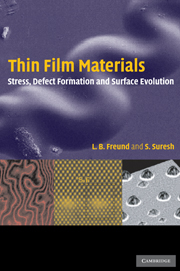Book contents
- Frontmatter
- Contents
- Preface
- 1 Introduction and Overview
- 2 Film stress and substrate curvature
- 3 Stress in anisotropic and patterned films
- 4 Delamination and fracture
- 5 Film buckling, bulging and peeling
- 6 Dislocation formation in epitaxial systems
- 7 Dislocation interactions and strain relaxation
- 8 Equilibrium and stability of surfaces
- 9 The role of stress in mass transport
- References
- Author index
- Subject index
4 - Delamination and fracture
Published online by Cambridge University Press: 06 July 2010
- Frontmatter
- Contents
- Preface
- 1 Introduction and Overview
- 2 Film stress and substrate curvature
- 3 Stress in anisotropic and patterned films
- 4 Delamination and fracture
- 5 Film buckling, bulging and peeling
- 6 Dislocation formation in epitaxial systems
- 7 Dislocation interactions and strain relaxation
- 8 Equilibrium and stability of surfaces
- 9 The role of stress in mass transport
- References
- Author index
- Subject index
Summary
Any material that transmits mechanical load from one place to another is susceptible to fracture. This susceptibility is enhanced if the geometry of the object includes reentrant corners, internal defects or other geometrical variations which serve as sites of stress concentration. At these sites, the local stress can be much larger than the nominal stress, which is loosely defined as the average stress transmitted at a cross-sectional area. As a consequence of stress concentration, the local stress can exceed the strength of the material and fracture ensues, even though the nominal stress is well below the fracture strength.
Mechanical interactions between a thin film and a substrate to which it is bonded were the focus of discussion in the preceding chapters. These interactions, when occurring in the absence of any failure or delamination processes, are manifested in a number of ways: the constraint of the substrate prevents the film from relaxing its internal stress, and the film–substrate system accommodates the internal stress by in-plane stretch or contraction, substrate curvature and/or plastic yielding of the film. However, when edge effects are neglected, the traction exerted by the film and substrate material on each other across the film–substrate interface is zero everywhere. If this is the case, how do the film and substrate interact?
- Type
- Chapter
- Information
- Thin Film MaterialsStress, Defect Formation and Surface Evolution, pp. 220 - 311Publisher: Cambridge University PressPrint publication year: 2004
- 1
- Cited by



